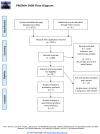Contact tracing of tuberculosis: a systematic review of transmission modelling studies
- PMID: 24023742
- PMCID: PMC3762785
- DOI: 10.1371/journal.pone.0072470
Contact tracing of tuberculosis: a systematic review of transmission modelling studies
Abstract
The WHO recommended intervention of Directly Observed Treatment, Short-course (DOTS) appears to have been less successful than expected in reducing the burden of TB in some high prevalence settings. One strategy for enhancing DOTS is incorporating active case-finding through screening contacts of TB patients as widely used in low-prevalence settings. Predictive models that incorporate population-level effects on transmission provide one means of predicting impacts of such interventions. We aim to identify all TB transmission modelling studies addressing contact tracing and to describe and critically assess their modelling assumptions, parameter choices and relevance to policy. We searched MEDLINE, SCOPUS, COMPENDEX, Google Scholar and Web of Science databases for relevant English language publications up to February 2012. Of the 1285 studies identified, only 5 studies met our inclusion criteria of models of TB transmission dynamics in human populations designed to incorporate contact tracing as an intervention. Detailed implementation of contact processes was only present in two studies, while only one study presented a model for a high prevalence, developing world setting. Some use of relevant data for parameter estimation was made in each study however validation of the predicted impact of interventions was not attempted in any of the studies. Despite a large body of literature on TB transmission modelling, few published studies incorporate contact tracing. There is considerable scope for future analyses to make better use of data and to apply individual based models to facilitate more realistic patterns of infectious contact. Combined with a focus on high burden settings this would greatly increase the potential for models to inform the use of contract tracing as a TB control policy. Our findings highlight the potential for collaborative work between clinicians, epidemiologists and modellers to gather data required to enhance model development and validation and hence better inform future public health policy.
Conflict of interest statement
Similar articles
-
Measures implemented in the school setting to contain the COVID-19 pandemic.Cochrane Database Syst Rev. 2022 Jan 17;1(1):CD015029. doi: 10.1002/14651858.CD015029. Cochrane Database Syst Rev. 2022. Update in: Cochrane Database Syst Rev. 2024 May 2;5:CD015029. doi: 10.1002/14651858.CD015029.pub2. PMID: 35037252 Free PMC article. Updated.
-
Cost-effectiveness of using prognostic information to select women with breast cancer for adjuvant systemic therapy.Health Technol Assess. 2006 Sep;10(34):iii-iv, ix-xi, 1-204. doi: 10.3310/hta10340. Health Technol Assess. 2006. PMID: 16959170
-
Comparison of self-administered survey questionnaire responses collected using mobile apps versus other methods.Cochrane Database Syst Rev. 2015 Jul 27;2015(7):MR000042. doi: 10.1002/14651858.MR000042.pub2. Cochrane Database Syst Rev. 2015. PMID: 26212714 Free PMC article.
-
Behavioral interventions to reduce risk for sexual transmission of HIV among men who have sex with men.Cochrane Database Syst Rev. 2008 Jul 16;(3):CD001230. doi: 10.1002/14651858.CD001230.pub2. Cochrane Database Syst Rev. 2008. PMID: 18646068
-
Interventions for preventing and reducing the use of physical restraints for older people in all long-term care settings.Cochrane Database Syst Rev. 2023 Jul 28;7(7):CD007546. doi: 10.1002/14651858.CD007546.pub3. Cochrane Database Syst Rev. 2023. PMID: 37500094 Free PMC article.
Cited by
-
Prioritising attributes for tuberculosis preventive treatment regimens: a modelling analysis.BMC Med. 2022 May 18;20(1):182. doi: 10.1186/s12916-022-02378-1. BMC Med. 2022. PMID: 35581650 Free PMC article.
-
Investigation of household contacts of pulmonary tuberculosis patients increases case detection in Mwanza City, Tanzania.BMC Infect Dis. 2018 Mar 6;18(1):110. doi: 10.1186/s12879-018-3036-6. BMC Infect Dis. 2018. PMID: 29510670 Free PMC article.
-
California's COVID-19 Virtual Training Academy: Rapid Scale-Up of a Statewide Contact Tracing and Case Investigation Workforce Training Program.Front Public Health. 2021 Aug 9;9:706697. doi: 10.3389/fpubh.2021.706697. eCollection 2021. Front Public Health. 2021. PMID: 34434915 Free PMC article.
-
Design, Implementation, and Outcomes of a Volunteer-Staffed Case Investigation and Contact Tracing Initiative at an Urban Academic Medical Center.JAMA Netw Open. 2022 Sep 1;5(9):e2232110. doi: 10.1001/jamanetworkopen.2022.32110. JAMA Netw Open. 2022. PMID: 36149656 Free PMC article.
-
Contact tracing - Old models and new challenges.Infect Dis Model. 2020 Dec 30;6:222-231. doi: 10.1016/j.idm.2020.12.005. eCollection 2021. Infect Dis Model. 2020. PMID: 33506153 Free PMC article.
References
-
- WHO (2012) Tuberculosis: WHO fact sheet no. 104. Available: http://www.who.int/mediacentre/factsheets/fs104/en/. Accessed 2012 Aug 7.
-
- WHO (2012) GLOBAL TUBERCULOSIS REPORT 2012. Elsevier.
-
- WHO (2006) THE STOP TB STRATEGY.
-
- WHO (2011) Global Tuberculosis Control 2011.
-
- Glaziou P, Floyd K, Korenromp EL, Sismanidis C, Bierrenbach AL, et al. (2011) Lives saved by tuberculosis control and prospects for achieving the 2015 global target for reducing tuberculosis mortality. Bulletin of the World Health Organization 89: 573–582 doi:10.2471/BLT.11.087510 - DOI - PMC - PubMed
Publication types
MeSH terms
LinkOut - more resources
Full Text Sources
Other Literature Sources
Medical
Miscellaneous


